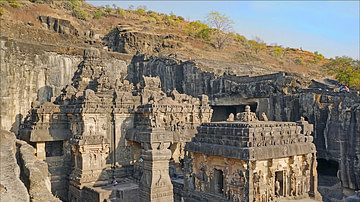The great Hindu god Shiva has many guises and many representations in art, but perhaps the most familiar is as a dancing figure within a circle of fire, that is as Shiva Nataraja, Lord of the Dance. It is an image seen in museums, temples, restaurants, and esoteric shops across the world, and it is wonderfully rich in iconography and hidden meaning.
Shiva, as many other important Hindu gods, is a complex character with a myriad of traits, sometimes seemingly in conflict with each other. Accordingly, in his guise as Nataraja he is represented in his triple role as Creator, Preserver and Destroyer. Shiva as a dancing figure first appeared in Indian stone temple sculpture in the 5th and 6th century CE, and it was not until the 10th century CE that the now familiar free-standing sculptural representation, typically in bronze, became standard. In this remarkably standardized form, the god is shown dancing within a flaming halo (prabha mandala) which represents Time and which is shown as a circle to symbolize the Hindu belief that it is both cyclical and without end. The flames of the ring sprout from the mouths of makaras or mythical sea creatures shown at the base of the sculpture. The ring is more arch-like in the first bronze sculptures, as can be seen in one of the earliest surviving, the c. 875 CE sculpture within the Shiva temple at Nallur near Tanjavur. Eventually, though, a perfect circle becomes the norm.
The dance the smiling Shiva is performing is the Tandava, the cosmic dance which both creates and destroys the universe. The energy and wildness of the dance is shown in his bent knees and the extravagant spreading of the god's hair. Shiva's locks also contain a skull, a datura blossom, and a crescent moon which represents the idea that Shiva is ever-present even if sometimes he is not always visible. Even more prominent is the figure of Ganga, the personification of the river Ganges, who, according to Hindu mythology, was brought gently from the heavens down to earth in the god's hair. Sometimes the god's hair is topped with a fan of konnai leaves.
Shiva is providing his own music, as in his upper right hand he holds a small drum – the damaru (usually taking the shape of an hour-glass) – which provides not only rhythm but also reminds that it was this drum which made the first sounds of the creation. The beat of the drum is also considered to provide the heartbeat of the cosmos, the maya. Conversely, in Shiva's upper left hand he holds agni, the divine fire, which will destroy the universe.

Shiva's lower right hand makes the abhaya mudra gesture of blessing which calms all fear, and the lower left arm sweeps across his torso with the hand pointing to his left foot in the gesture of gaja hasta, symbol of salvation and liberation. Shiva's right foot is shown stamping on the dwarf figure Apasmara Purusha, who holds a cobra and who represents illusion and ignorance, leading humanity away from truth. The cobra motif is repeated and hangs slain from Shiva's right arm. The god usually wears only a short dhoti which is tied around his waist with a sash. Typically, the two ends of the sash billow to the god's dancing movement and reach out to join the ring of fire. Shiva also wears jewellery – necklaces, armlets, and anklets.
The image of Shiva as Nataraja was especially popular in the Chola period, when craftsmen produced large quantities of the figure sculpture in bronze and, measuring up to 1.4 metres in height, they were often carried in religious processions and festivals to represent the god. Early examples can be identified by the straightened sides of the ring of fire, as mentioned above, but also by the absence of Ganga and the fact the individual flames have only three points. In later sculptures Shiva also wears a bell around his standing leg. The figure of Shiva Nataraja has become perhaps the most widespread icon of Hinduism, and the bronze sculptures are still produced today in parts of southern India and especially around Chidambaram where ancient legend tells that Shiva once performed his dance of creation and destruction in a grove of tillai trees.






